| Western blot (WB): | 1:2000 |
| Immunohistochemistry (IHC): | 1:50 |
| Immunocytochemistry/Immunofluorescence (ICC/IF): | 1:100 |
| Flow cytometry (FCM): | 1:100 |
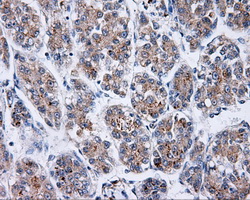
Immunohistochemical staining of paraffin-embedded Carcinoma of liver tissue using anti-BTK mouse monoclonal antibody. (Heat-induced epitope retrieval by 10mM citric buffer, pH6.0, 100°C for 10min, M00245-3, Dilution 1:50)
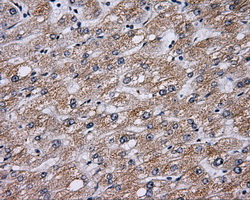
Immunohistochemical staining of paraffin-embedded liver tissue within the normal limits using anti-BTK mouse monoclonal antibody. (Heat-induced epitope retrieval by 10mM citric buffer, pH6.0, 100°C for 10min, M00245-3, Dilution 1:50)
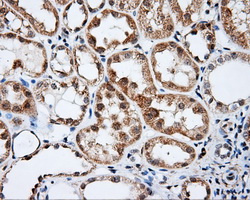
Immunohistochemical staining of paraffin-embedded Kidney tissue within the normal limits using anti-BTK mouse monoclonal antibody. (Heat-induced epitope retrieval by 10mM citric buffer, pH6.0, 100°C for 10min, M00245-3, Dilution 1:50)
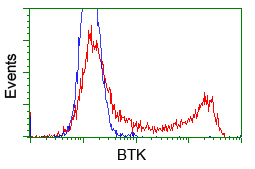
HEK293T cells transfected with either pCMV6-ENTRY BTK (Red) or empty vector control plasmid (Blue) were immunostained with anti-BTK mouse monoclonal (M00245-3), and then analyzed by flow cytometry.
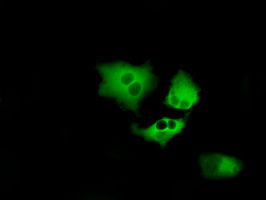
Anti-BTK mouse monoclonal antibody immunofluorescent staining of COS7 cells transiently transfected by pCMV6-ENTRY BTK .
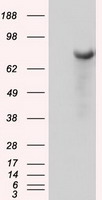
HEK293T cells were transfected with the pCMV6-ENTRY control (Left lane) or pCMV6-ENTRY BTK (Right lane) cDNA for 48 hrs and lysed. Equivalent amounts of cell lysates (5 ug per lane) were separated by SDS-PAGE and immunoblotted with anti-BTK.
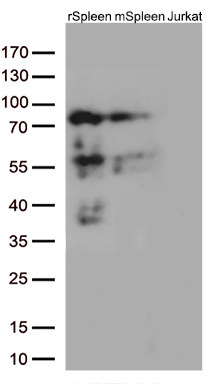
Western blot analysis of extracts (35ug) from 2 different tissues and Jurkat cells by using anti-BTK monoclonal antibody (1:500).

Immunohistochemical staining of paraffin-embedded Carcinoma of liver tissue using anti-BTK mouse monoclonal antibody. (Heat-induced epitope retrieval by 10mM citric buffer, pH6.0, 100°C for 10min, M00245-3, Dilution 1:50)

Immunohistochemical staining of paraffin-embedded liver tissue within the normal limits using anti-BTK mouse monoclonal antibody. (Heat-induced epitope retrieval by 10mM citric buffer, pH6.0, 100°C for 10min, M00245-3, Dilution 1:50)

Immunohistochemical staining of paraffin-embedded Kidney tissue within the normal limits using anti-BTK mouse monoclonal antibody. (Heat-induced epitope retrieval by 10mM citric buffer, pH6.0, 100°C for 10min, M00245-3, Dilution 1:50)

HEK293T cells transfected with either pCMV6-ENTRY BTK (Red) or empty vector control plasmid (Blue) were immunostained with anti-BTK mouse monoclonal (M00245-3), and then analyzed by flow cytometry.

Anti-BTK mouse monoclonal antibody immunofluorescent staining of COS7 cells transiently transfected by pCMV6-ENTRY BTK .

HEK293T cells were transfected with the pCMV6-ENTRY control (Left lane) or pCMV6-ENTRY BTK (Right lane) cDNA for 48 hrs and lysed. Equivalent amounts of cell lysates (5 ug per lane) were separated by SDS-PAGE and immunoblotted with anti-BTK.

Western blot analysis of extracts (35ug) from 2 different tissues and Jurkat cells by using anti-BTK monoclonal antibody (1:500).






